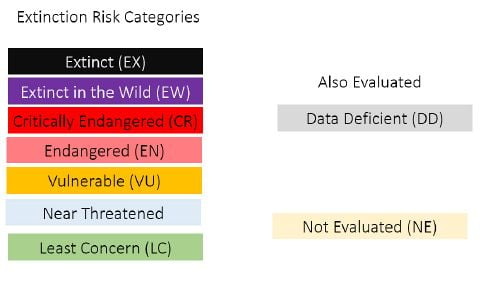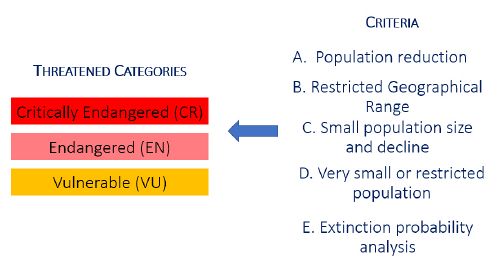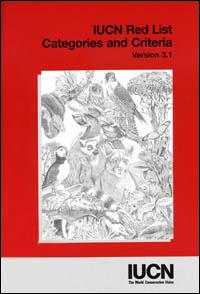IUCN Red List
The IUCN Red List of Threatened Species™ is an extensive information source on the conservation status of animals, plants, and fungi worldwide, utilizing a standardized set of criteria to evaluate their extinction risk and placing them into one of nine IUCN Red List Categories, such as Extinct (EX), Critically Endangered (CR), Vulnerable (VU), and so forth. Also known as the IUCN Red List or Red Data List, this inventory is produced by the Species Survival Commission (SSC) of the International Union for Conservation of Nature (IUCN). The IUCN Red List Committee oversees the work of the Species Survival Commission. In addition to extinction risk, the IUCN Red List provides information on each assessed species' range, population size, habitat and ecology, threats, use and trade, and conservation action. As of April 2024, over 157,190 species have been evaluated for the IUCN Red List, and Red list reports that 44,000 are threatened with extinction, including 41% of amphibians, 37% of sharks and rays, 36% of reef-building corals, 34% of conifers, 26% of mammals,21% of reptiles, and 12% of birds (IUCN 2024).
The current nine RED List Categories include seven by which the extinction risk for a species has been evaluated. These seven are, in order of extinction risk: Extinct (EX), Extinct in the Wild (EW), Critically Endangered (CR), Endangered (EN), Vulnerable (VU), Near Threatened (NT), and Least Concern (LC). There is also one category for species that have been evaluated, but the information is not sufficient to determine extinct risk: Data Deficient (DD). There is also a Not Evaluated (NE) category. These present nine categories, and precise criteria to determine the extinction threat status for a species, were adopted in 2001.
The IUCN Red List was first conceived of in 1963, when standards were set for species listing and conservation assessment efforts. In 1988, all bird species were evaluated, and the 1996 IUCN Red List of Threatened Animals included the conservation status of all known mammal species. In 2000, the Red List made a single list for the first time of animal and plant assessments, with 18,000 species assessments. Now too large to be easily published as a book, the IUCN Red List is made available online, on a searchable directory.
For people to properly fulfill a role as stewards of nature, they need assessment tools that allow them to understand the current status of various species, the trends in the health of their populations, and the impacts of anthropogenic factors. Habitat degradation and fragmentation, pollution, and invasive species are among the direct human impacts on species population levels. The IUCN Red List, which reflects a growing international awareness and cooperation, provides a comprehensive tool for governments, media, NGOs, intergovernmental bodies, and so forth to gain access to important information on biodiversity when environment-related decisions are to be made.
Overview
The IUCN Red List is created under the auspices of the International Union for Conservation of Nature (IUCN), a global environmental organization whose membership consists of governments, intergovernmental bodies, and international and national NGOs. The IUCN, which is headquartered in Gland, Switzerland, but has offices in more than 50 nations, and over 1400 members from over 170 countries, is considered the world's main authority on the conservation status of species (IUCN 2024).
The IUCN Red List is considered the world's most comprehensive inventory of the global conservation status of plant and animal species (IUCN 2008a). It presents various categories regarding the extinction status or risk and evaluates them according to a set of quantitative criteria based on biological factors related to extinction risk, such as population size, rate of decline, and so forth. These criteria are considered to be relevant to all species and all regions of the world. A series of Regional Red Lists are produced by countries or organizations, which assess the risk of extinction to species within a political management unit. Assessments for the Red List are made of animals, plant and fungi species, subspecies, varieties (plants only) and subpopulations, but assessments must be made on the species level before subspecies, varieties, or subpopulations can be made. Hybrids of species, microorganisms, and domesticated taxa are not included. Some nations have their own national Red Lists for monitoring biodiversity within their own borders (IUCN 2024).
The IUCN Red List is widely considered to be the most objective and authoritative system for classifying species in terms of the risk of extinction (BI 2008).
The IUCN Red List is produced by the IUCN Species Survival Commission, a network of thousands of species experts. The IUCN Red List Partnership are members and partners of IUCN that are making significant technical or financial contributions to the IUCN Red List and consists of four main organizations: Conservation International, BirdLife International, NatureServe, and Zoological Society of London.
Major species assessors include BirdLife International, the Institute of Zoology (the research division of the Zoological Society of London), the World Conservation Monitoring Centre, and many Specialist Groups within the IUCN's Species Survival Commission (SSC). Collectively, assessments by these organizations and groups account for nearly half the species on the Red List. BirdLife International is considered the Red List Authority (RLA) for birds (IUCN 2008a).
The IUCN aims to have the category of every species re-evaluated every five years if possible, or at least every ten years. This is done in a peer reviewed manner through IUCN Species Survival Commission (SSC) Specialist Groups, which are Red List Authorities responsible for a species, group of species or specific geographic area, or in the case of BirdLife International, an entire class (Aves).
There are currently about 2 million known (described) species, of which less than ten percent have been assessed for the Red List (IUCN 2024).
Categories
Species in the IUCN Red List are classified in nine groups:
- Extinct (EX)
- Extinct in the Wild (EW)
- Critically Endangered (CR)
- Endangered (EN)
- Vulnerable (VU)
- Near Threatened (NT)
- Least Concern (LC)
- Data Deficient (DD)
- Not Evaluated (NE)
When discussing the IUCN Red List, the official terminology threatened, or species threatened with extinction, is a grouping of three categories: Critically Endangered, Endangered, and Vulnerable. These are evaluated according to five biological factors: population reduction, restricted geographic range, small population size & decline, very small or restricted population, and extinction probability analysis. The Critically Endangered Category species may also be further tagged as Possibly Extinct or Extinct in the Wild. There could also be regional assessments of "Regionally Extinct" or "Not Applicable" (IUCN 2024).
The IUCN Red List of Threatened Species uses the term endangered species as a specific category of imperilment, rather than as a general term. Under the IUCN Categories and Criteria, endangered species is between critically endangered and vulnerable. Also critically endangered species may also be counted as endangered species and fill all the criteria. The more general term used by the IUCN for species at risk of extinction is threatened species, which also includes the less-at-risk category of vulnerable species (together with endangered and critically endangered).
IUCN categories include:
- Extinct. A taxon is considered Extinct the last remaining member of the species has died, or is presumed beyond reasonable doubt to have died. Examples: thylacine, dodo, passenger pigeon
- Extinct in the Wild. A taxon is considered Extinct in the Wild when it is only known to survive in captivity, in cultivation, or in a naturalized population well outside the past range. Examples:South China tiger, Alagoas curassow
- Critically Endangered. A taxon is considered Critically Endangered when it faces an extremely high risk of extinction in the immediate future. It needs to meet any of the five criteria (A to E) for Critical Endangered (see image). Examples: Arakan forest turtle, Javan rhino, Brazilian merganser
- Endangered. A taxon is considered Endangered when it faces a very high risk of extinction in the near future. It must meet any of the five criteria for Endangered. Examples: blue whale, snow leopard, African wild dog, tiger, albatross, crowned solitary eagle
- Vulnerable. A taxon is considered Vulnerable when it faces a high risk of extinction in the medium-term. It needs to meet any of the five criteria for Vulnerable. Examples: cheetah, gaur, lion, wolverine
- Near Threatened. A taxon is considered Near Threatened when it may be considered threatened in the near future. It does not qualify according to the five criteria for Critically Endangered, Endangered, or Vulnerable at the present time, but is close to qualifying or likely to qualify in the near future. Examples: blue-billed duck, solitary eagle, small-clawed otter, maned wolf
- Least Concern. A taxon is considered Least Concern when there is no immediate threat to the survival of the species. It is evaluated against the criteria and does not qualify for any of the above categories. Examples: brown rat, Nootka cypress, wood pigeon
- Data Deficient. A taxon is considered Data Deficient when there is inadequate information to make a direct or indirect assessment of the risk of extinction based on distribution and/or population status. The taxon may be well studied, but data on its abundance or distribution is lacking to make an assessment on extinction risk.
- Not Evaluated. A taxon is considered Not Evaluated if has not yet been evaluated against the criteria.
Possibly Extinct
The additional category of Possibly Extinct (Butchart et al. 2006) is used by Birdlife International, the Red List Authority for birds for the IUCN Red List (BI 2008). Birdlife International has recommended PE become an official category. BirdLife International has not stated whether a "Possibly Extinct in the Wild" category should also be added, although it is mentioned that Spix's macaw has this status. "Possibly Extinct" can be considered a subcategory of "Critically Endangered," like the Chinese river dolphin, which is considered critically endangered.
Recent releases
2006 release
The 2006 Red List, released on May 4, 2006, evaluated 40,168 species as a whole, plus an additional 2,160 subspecies, varieties, aquatic stocks, and subpopulations.
From the species evaluated as a whole, 16,118 were considered threatened. Of these, 7,725 were animals, 8,390 were plants, and three were lichen and mushrooms.
This release listed 784 species extinctions recorded since 1500 C.E., unchanged from the 2004 release. This was an increase of 18 from the 766 listed as of 2000.. Each year a small number of "extinct" species may be rediscovered, becoming Lazarus species, or may be reclassified as "data deficient." In 2002, the extinction list dropped to 759 species, but has been rising ever since.
2007 release
On September 12, 2007, the IUCN released the 2007 IUCN Red List of Threatened Species, the latest update to their online database of species' extinction risks. In this release, they have raised their classification of both the Western lowland gorilla (Gorilla gorilla gorilla) and the cross river gorilla (Gorilla gorilla diehli) from Endangered to Critically Endangered, which is the last category before Extinct in the Wild, due to Ebola virus and poaching, along with other factors. Russ Mittermeier, chief of Swiss-based IUCN's Primate Specialist Group, stated that 16,306 species are endangered with extinction, 188 more than in 2006, with a total of 41,415 species on the Red List. The Red List includes the Sumatran orangutan (Pongo abelii) in the Critically Endangered category and the Bornean orangutan (Pongo pygmaeus) in the Endangered category (IUCN 2007).
2008 release
The 2008 Red List was released on October 6, 2008, at the IUCN World Conservation Congress in Barcelona, Spain, and "has confirmed an extinction crisis, with almost one in four [mammals] at risk of disappearing forever" (IUCN 2008b). The study shows at least 1,141 of the 5,487 mammals on Earth are known to be threatened with extinction, and 836 are listed as Data Deficient (IUCN 2008b).
2012 release
The Red List of 2012 was released 19 July 2012 at Rio+20 Earth Summitl nearly 2,000 species were added.
Current releases
In 2000, IUCN placed assessments from the 1996 IUCN Red List of Threatened Animals and The World List of Threatened Trees into an electronic Red List, which marked the beginning of The IUCN Red List website. At the time, there were a little over 16,500 species included on the list, with the website listing only very basic information. The website now includes a great deal of information on each species listed, such as distribution map, geographic range, population, habitat and ecology, threats, trade, taxonomy, assessment information, and conservation actions. It includes images for many species. The IUCN Red list is no longer available as a printed publication, given that it has grown in such size. As of April 2024, it included assessments for more than 157,100 species, more than 3,300 subspecies and plant varieties, and more than 27,700 regional assessments.
As of 2024, the Red List is updated a few times per year. For example, in 2024, the IUCN set up the dates of June 27 and October 22 for releases. The IUCN updates are often timed to coincide with major meetings among conservation groups (CITES meetings, IUCN World Conservation Congress, etc.). In some years, when there are multiple events of significance, the IUCN Red list may be updated more than twice a year.
The IUCN Red List website does not include Not Evaluated species. However, a search of the website includes a search for both the IUCN Red List and Catalogue of Life websites, such that if a species is not on the Red List website, it may show the title of Catalogue of Life (usually meaning the species has not yet been assessed for the IUCN Red list and is therefore considered Not Evaluated (NE).
ReferencesISBN links support NWE through referral fees
- Birdlife International (BI). 2008. Birds on the IUCN Red List. Birdlife International.
- Butchart, S. H. M., A. J. Stattersfield, and T. M. Brooks. 2006. Going or gone: Defining "Possibly Extinct" species to give a truer picture of recent extinctions. Bull. B.O.C. 126A: 7-24.
- International Union for Conservation of Nature and Natural Resources (IUCN). 2024. International Union on Conservation of Nature. IUCN. Retrieved April 7, 2024.
- —. 2001. Categories and criteria (version 3.1). IUCN. Retrieved January 4, 2009.
- —. 2008a. About the IUCN Red List. IUCN. Retrieved January 4, 2009.
- —. 2008b. IUCN Red List reveals world’s mammals in crisis. IUCN. Retrieved January 4, 2009.
- —. 1994. Categories and criteria (version 2.3). IUCN. Retrieved January 4, 2009.
- Mrosovsky, N. 1997. IUCN's credibility critically endangered. Nature 389(6650): 436. Retrieved January 4, 2009.
- Possingham, H. P., S. J. Andelmanb, M. A. Burgman, et al. 2002. Limits to the use of threatened species lists. Trends in Ecology & Evolution 17(11): 503–507. Retrieved January 4, 2009.
- Rodrigues, A. S. L., J. D. Pilgrim, J. F. Lamoreux, M. Hoffmann, and T. M. Brooks. 2006. The value of the IUCN Red List for conservation. Trends in Ecology & Evolution 21(2): 71-76.
Credits
New World Encyclopedia writers and editors rewrote and completed the Wikipedia article in accordance with New World Encyclopedia standards. This article abides by terms of the Creative Commons CC-by-sa 3.0 License (CC-by-sa), which may be used and disseminated with proper attribution. Credit is due under the terms of this license that can reference both the New World Encyclopedia contributors and the selfless volunteer contributors of the Wikimedia Foundation. To cite this article click here for a list of acceptable citing formats.The history of earlier contributions by wikipedians is accessible to researchers here:
The history of this article since it was imported to New World Encyclopedia:
Note: Some restrictions may apply to use of individual images which are separately licensed.



